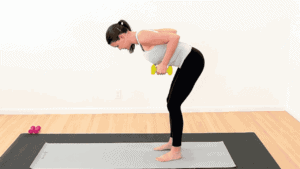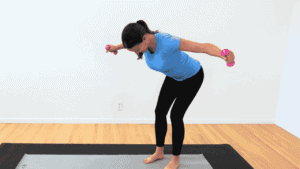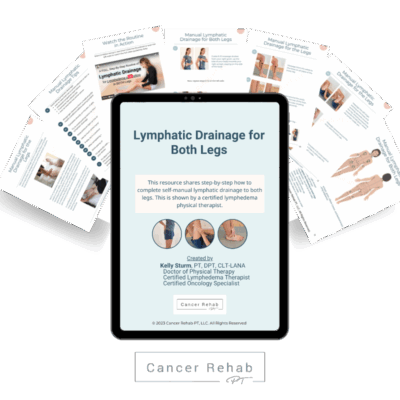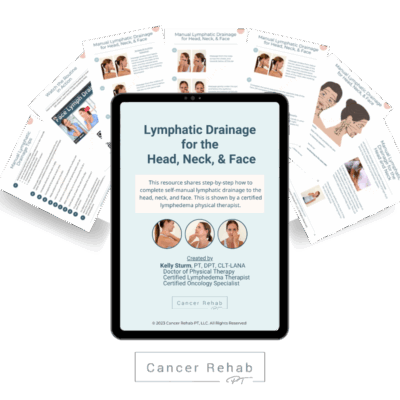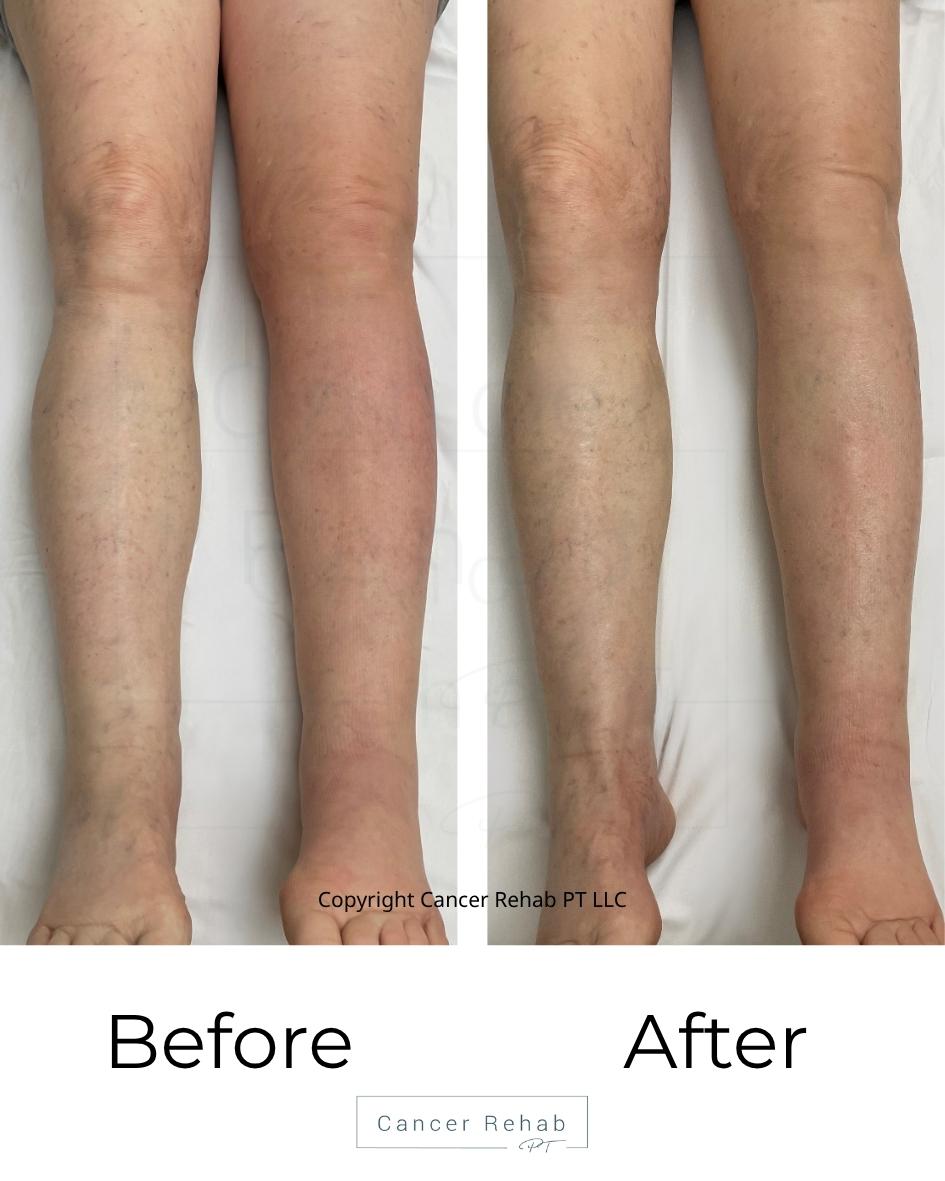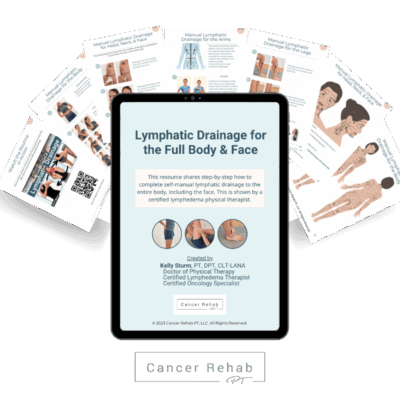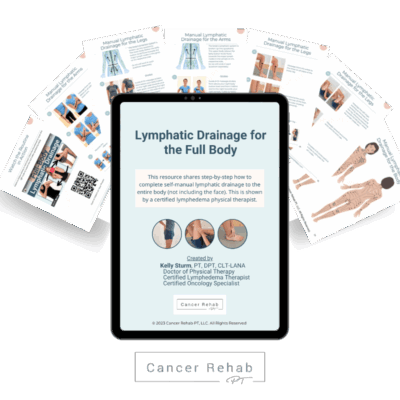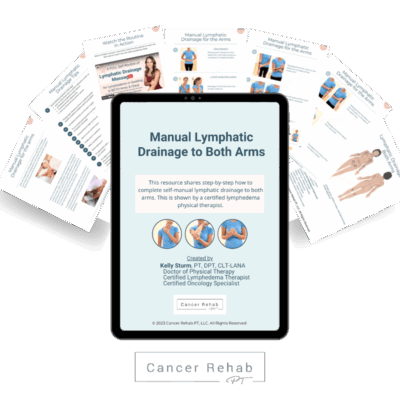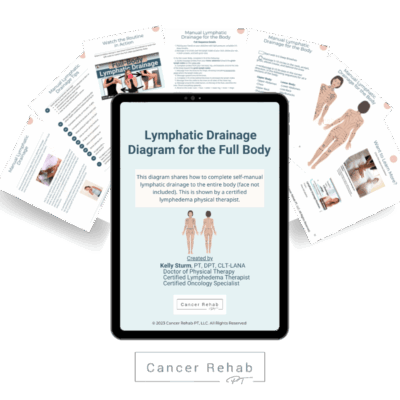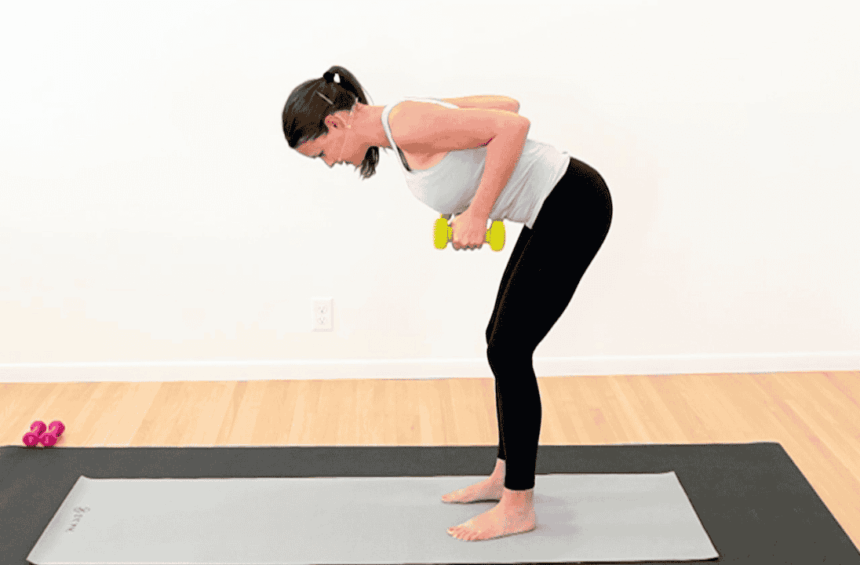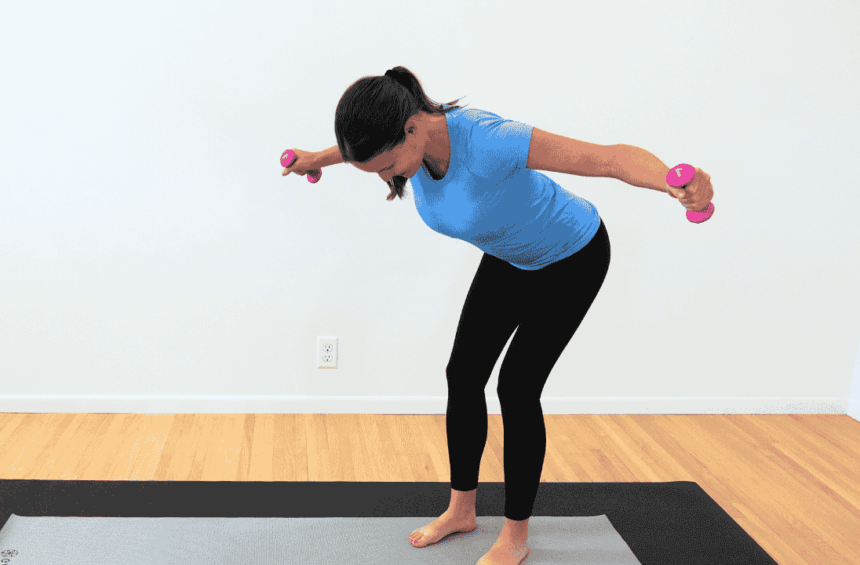Lymphatic drainage massage is a gentle technique that stimulates the movement of lymph fluid through your body. As a certified lymphedema therapist who’s taught hundreds of patients how to do lymphatic drainage at home, I often get asked about this technique.
This rhythmic massage helps remove toxins, reduce inflammation, and support the immune system. Here’s a before-and-after of lymphatic drainage massage:

You can use manual lymphatic drainage techniques to maintain a healthy lymphatic system and improve morning puffiness and general swelling, such as during pregnancy. It’s also an important part of managing medical conditions like lymphedema.
However, it’s important to follow a reputable routine or work with a certified lymphedema therapist. With lymphatic massage trending on social media, I’ve seen too many people doing it incorrectly and wondering why it doesn’t work.
What Is Lymphatic Drainage Massage?
Here’s how I explain the lymphatic system to my patients. It acts like your body’s drainage network, but unlike your heart pumping blood, it doesn’t have its own pump. Instead, it relies on muscle movement, deep breathing, and gentle manual pressure to move fluid along.
When this system gets sluggish or damaged, fluid can build up in your tissues, causing swelling and discomfort.
Manual lymphatic drainage is a supportive self-care routine that you can do from home, but only if you learn the proper technique.
It’s a gentle and noninvasive way to encourage the natural movement of lymph fluid through the body, while improving circulation. The massage uses very light, rhythmic strokes that barely indent the skin, much gentler than a regular massage.
Benefits of Manual Lymphatic Drainage
There are many benefits of lymphatic drainage massage, such as better immune function, less swelling, and detoxification:
- Reduces fluid buildup: The massage moves trapped lymph fluid back into circulation, which decreases swelling in your face, legs, arms, or anywhere fluid has accumulated. This is especially helpful after surgery or for people with lymphedema—I see significant improvements in my patients who do this consistently.
- Supports your body’s natural detox process: By encouraging lymph flow, the massage helps your body eliminate waste products and toxins more efficiently. But let me be clear: this isn’t some dramatic “detox” like you see on social media. It’s just helping your body do what it already does naturally.
- Strengthens immune function: Your lymphatic system transports infection-fighting white blood cells throughout your body. When lymph moves better, your immune system works more effectively—something that’s especially important if you’re dealing with chronic health issues.
- Speeds recovery after surgery or injury: The gentle massage speeds up your recovery time after surgery or injury by reducing inflammation, bruising, and even the formation of scar tissue.
- Provides relief for chronic conditions: People with lymphedema, fibromyalgia, and other conditions that cause swelling often find significant relief through regular lymphatic massage as a part of their physical therapy.
- Improves skin health: Manual lymphatic drainage could be a useful addition to your skin care routine because it can reduce puffiness in the face, which can help your skin appear clearer and more radiant without using any extra face products.
- Promotes relaxation and better mood: The rhythmic, gentle strokes have a calming effect that can reduce stress and help you feel more relaxed.
- Reduces digestive bloating: Stimulating lymph flow around the gut can relieve bloating and water retention.
Here’s a before-and-after lymphatic drainage massage for a woman living with lymphedema of the leg:
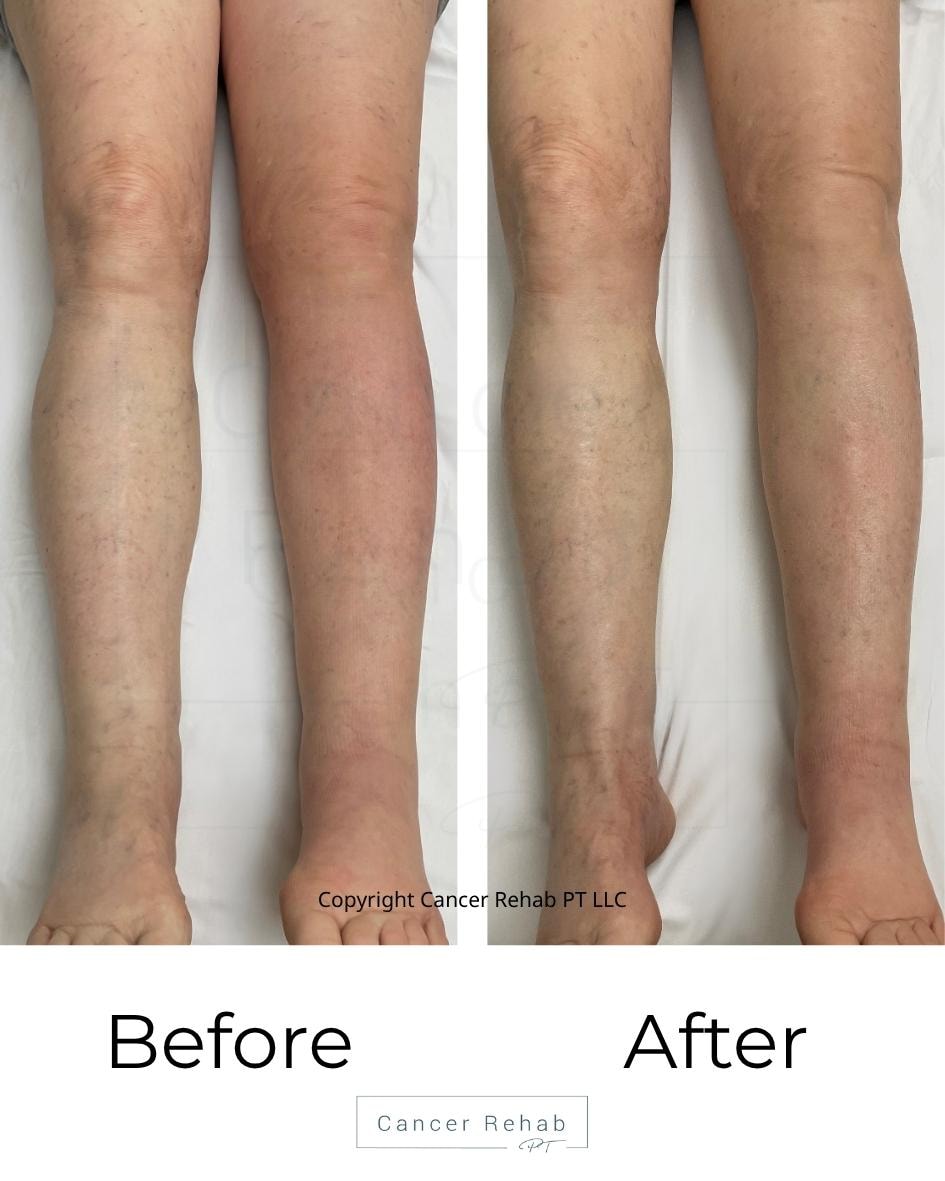
While the benefits of lymphatic drainage massage are plenty, there are also instances where it is considered dangerous and should be avoided—something I always discuss with my patients before we start.
What Are the Symptoms of Poor Lymphatic Drainage?
Before you decide if this therapeutic massage is right for you, it’s important to know what the symptoms of poor lymphatic drainage are. The most common ones are:
- Fluid retention and swelling: You may notice puffiness or swelling in your arms, legs, face, hands, or feet that feels heavy or tight.
- Getting sick frequently: Since your lymphatic system helps circulate infection-fighting white blood cells, poor lymph flow can leave you more vulnerable to colds, infections, and other illnesses.
- Constant fatigue: This is something I hear about a lot from patients. When toxins aren’t cleared efficiently from your body, you may feel exhausted even after getting enough sleep.
- Facial puffiness and skin issues: You might wake up with a puffy face or notice your skin looks dull or has an uneven texture.
- Cold hands and feet: If your extremities stay cold regardless of the temperature, it could signal poor circulation in both your lymph and circulatory systems.
If you have lymphedema, a chronic condition where lymph fluid accumulates in tissues, lymphatic drainage massage becomes a very important part of your health routine.
Without proper drainage, the swelling can worsen over time and lead to serious complications like cellulitis. This is something I’ve unfortunately seen happen when patients don’t stay consistent with their care.
How to Do Lymph Drainage Massage
You can either learn to do lymphatic drainage massage at home or visit a qualified professional, like a certified lymphedema therapist or massage therapist trained in manual lymphatic drainage. When doing it yourself, it’s very important to follow a trusted, evidence-based resource from a trained professional.
Something that concerns me is that with lymphatic massage gaining popularity on social media, many wellness and beauty influencers are sharing tutorials, but not all of them understand the proper technique.
One common mistake you’ll see is directing strokes toward the heart when you should be moving fluid toward your nearest lymph nodes for proper drainage.
Before you start, you should make sure your hands are clean and that your skin is dry. You should sit in a relaxed position and breathe deeply to stimulate lymph flow. You should only use light pressure, as if you’re stretching your skin.
The pressure should not resemble the type you receive when you go in for a muscle massage, because lymph vessels are just under the skin and don’t need deep stimulation.
What to Do Before and After Lymphatic Drainage Massage?
There’s not that much you need to do to prepare for your lymphatic drainage massage or to wrap up your session. Unlike traditional massages, it’s an easy routine that only takes 10-20 minutes.
Before your massage:
- Drink 1-2 glasses of water for proper hydration
- Eat a light meal 1-2 hours before your session
- Use the bathroom
- Wear loose, comfortable clothing that can be easily adjusted or removed
- Avoid alcohol and caffeine
- Arrive as relaxed as possible, since stress restricts lymph flow and makes the massage less effective
After your massage, drink plenty of water to help flush out the waste products that were mobilized during your session. You might feel energized and relaxed, or slightly tired and achy. I tell my patients that both reactions are completely normal!
How Long Does It Take to See Results from Lymphatic Drainage Massage?
In my experience, you’ll likely see noticeable improvements almost immediately, especially if you’ve been dealing with swelling, puffiness, and fluid retention. How quickly you see the results also depends on your unique body and the severity of the swelling.
Immediately after your massage, you’ll likely notice reduced swelling and puffiness in the legs, face, or abdomen.
You’ll also experience increased urination because of all the fluid movement. Don’t worry, this is exactly what we want to see! You’ll also feel lighter, less bloated, and may even experience an improvement in your sleep.
If you’re living with chronic swelling or lymphedema, I recommend experimenting with frequency to see what makes the biggest difference for you. Many of my patients do it daily to support their lymphatic health, while others find 3-4 times per week works well.
Lymphatic Drainage Massage and Lymphedema
Lymphedema is a chronic condition that causes swelling, usually in the legs or arms, because of excess fluid. The condition usually occurs after surgery, radiation, or trauma, and is common after cancer treatment, especially if it involved lymph nodes.
For those living with lymphedema, manual lymphatic drainage is a gentle and noninvasive self-care routine that can stimulate lymph flow in affected areas and help move stagnant fluid along. It reduces fluid retention and swelling, while also relieving heaviness, tightness, and discomfort.
While manual lymphatic drainage doesn’t cure lymphedema, it greatly manages symptoms and can help bring about some much-needed relief from the condition.
If you’re living with lymphedema, research shows that lymphatic drainage massage can be an important yet easy way to take care of yourself.
How Often Should You Do Lymphatic Drainage Massage?
There’s no set minimum or maximum frequency for lymphatic drainage massage. It’s all about finding what works best for your body.
Many people enjoy incorporating it into their daily self-care routine, either in the morning to reduce overnight puffiness or at night for relaxation. Others find that a couple of times per week gives them the benefits they’re looking for.
Experiment to see what makes the biggest positive difference for you, but doing it multiple times daily is likely excessive. For chronic health conditions like lymphedema, you’ll likely need ongoing sessions multiple times per week.
Should I Do Lymphatic Drainage at Night or Morning?
Each time of day offers different benefits, but honestly, the best time to do it is when you can be consistent!
The benefits of doing it in the morning are:
- Less morning puffiness and fluid retention
- Boosted circulation and blood flow to start your day
- Better detox after your body’s nightly natural cleansing
Overall, doing lymphatic drainage in the morning is a great idea if you often wake up sluggish, swollen, or bloated.
That said, there are also many benefits to doing it at night, such as:
- Better sleep
- Processing the day’s accumulated fluid and toxins
- Better overnight lymphatic flow, which usually peaks during rest
Manual lymphatic drainage massage can be a calming bedtime routine, which is also beneficial for your mental well-being.
Either way, there’s no right or wrong choice here. I encourage my patients to experiment with both to see what feels best for their body and lifestyle.
What to Avoid After Lymphatic Drainage Massage?
After your lymphatic massage, your body is actively processing and eliminating the fluids and toxins that were mobilized during your session. Avoiding certain activities helps ensure you get the maximum benefit and feel your best.
For the first 24 hours after your massage, avoid:
- Alcohol and caffeine, which can dehydrate you
- Strenuous exercise or intense physical activity
- Processed, salty, or very heavy meals
- Hot showers, saunas, or baths
Instead, focus on gentle movement, plenty of water, and nourishing foods to support your body.
Important Safety Considerations
As a healthcare professional, I need to emphasize that lymphatic drainage massage isn’t appropriate for everyone. You should avoid this technique if you have:
- Active infections or fever
- Blood clots or a history of blood clots
- Active cancer (unless cleared by your oncology team)
- Congestive heart failure
- Kidney problems
- Acute inflammation
Always check with your healthcare provider before starting any new therapy, especially if you have medical conditions.
FAQs
What comes out of your body during a lymphatic drainage massage?
Your body doesn’t dramatically “release” toxins the way some wellness trends suggest. Instead, the massage helps move trapped fluid from your tissues into your lymphatic vessels, where it eventually enters your bloodstream and gets filtered out through urine.
Your lymph nodes naturally filter out cellular waste like dead cells and metabolic byproducts, which your kidneys and liver then process and eliminate. So, toxins aren’t instantly “flushed out,” but lymphatic massage does support their gradual removal through your body’s natural detox systems.
Can you overdo lymphatic drainage?
Lymphatic drainage massage can be ineffective or lead to uncomfortable side effects if you’re doing it too aggressively or without proper guidance from a certified therapist. Most of the time, the worst thing that can happen is that it just doesn’t reduce swelling or puffiness. However, if you put too much pressure, it can also be uncomfortable. Manual lymph drainage uses light, gentle strokes.
Does lymphatic drainage help with weight loss?
Kind of. While lymphatic drainage massage doesn’t directly cause weight loss in terms of reducing body fat or body mass, it can support your weight loss efforts by helping your body function more efficiently. The immediate drop in inches or puffiness is because of fluid loss, not fat loss.
Does lymphatic drainage reduce cellulite?
It can reduce the appearance of cellulite but not the cellulite itself. Because cellulite can look worse when there’s fluid retention, and since lymphatic drainage helps reduce fluid retention, the result often helps your skin appear smoother and less dimpled.
What toxins are released after a lymphatic drainage massage?
Lymphatic drainage massage doesn’t release any “special” toxins in your body. It simply helps your lymphatic system do the job it’s already meant to do, which is to support your immune system and filter out waste products, such as urea, creatinine, and lactic acid.
More Support for Your Lymphatic System
Lymphatic drainage massage is a gentle and effective way to reduce everyday puffiness or manage swelling from a medical condition like lymphedema. If you’re holding on to a lot of water weight, it can help your lymphatic system start functioning optimally.
As someone who’s taught this technique to hundreds of patients, I can tell you that consistency and proper technique are key to seeing results.
For more help with swelling and lymphatic drainage, check out my programs Lower Body Lymphedema Rehab and Breast Cancer Rehab, or learn from my lymphatic drainage guides!

